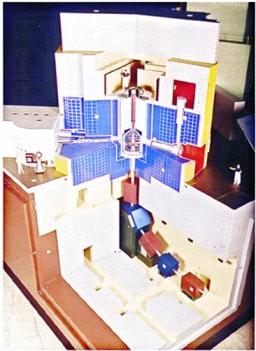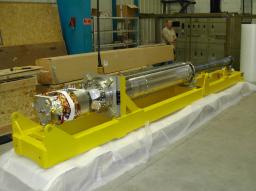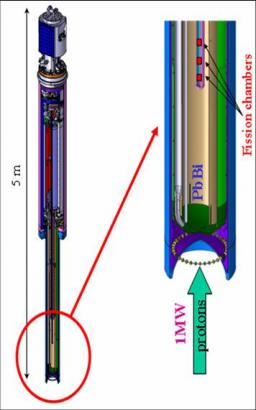
Mock-up of the Megapie (MEgawatt PIlot Experiment) experiment, where we see the dipoles of the beam line (bottom, in red), the target (in center) surrounding by the heavy water moderator (in blue).
Objectives:
Megapie (Megawatt pilot experiment) is an international project having as objectives to design, build, test and decomission the first lead-bismuth liquid spallation target functioning under 1 MW deposited power. This target is used as neutron source. Neutrons are produced by the interaction of high intensity proton beam (590 MeV of energy) on the target. To characterise the inner neutron flux (energy distribution and intensity), Dapnia has constructed and installed a neutron detector in the center of the target. The fundamental motivation is to validate integraly simulation codes used to describle the physics of spallation targets, including neutron production and transport.
Thematic/programs
Physics for nuclear energy/Nuclear data and modelisation
Context:
The achievement of sub-critical reactors, intrinsically safe, to incinerate nuclear wastes -by transmuting long-life actinides to shorter radioisotopes - or the production of neutrino beams or exotic nuclear beams, require intense neutron sources. These sources are produced by spallation reactions where high intensity proton beam impinges on heavy metal target. The only way to evacuate the high power deposited on the target by protons (few MW) and to reduce induced default in the material is to use liquid metals. In this context the Megapie experiment is pioneer and open the door towards high power targets.
Localization:
This experience was performed in 2006 at the Paul-Scherrer Institut (PSI), in Villigen in Switzerland. The target was installed in the SINQ hall. The construction of the neutron detector realised by Dapnia was done in France in collaboration with CEA/DEN Cadarache and industrial partners as Photonis, thermocoax, kayme, …
Dapnia contributions
Contributions:
Dapnia is strongly involved in the experiment by the construction and installation of the neutron detector and the analysis of recorded data. Measurements are really a success despite difficulties related to constraints in such targets: small overall dimensions, intense radiations, high temperature (400 °C) and weak signal to measure.
Scientific et technical responsabilities:
Dapnia is in charge of the neutron flux characterisation inside the target. This part is realised by the construction of the neutron flux detector, data taking, analysis and interpretation coupled with very detailed Monte Carlo simulations. It has also in charge the evaluation of the production of radioactive residues.





